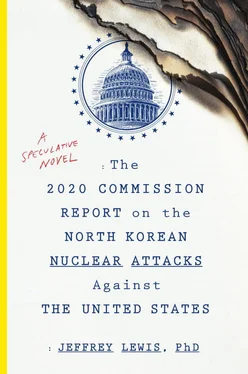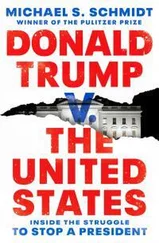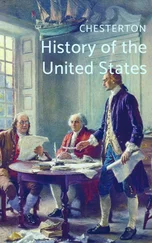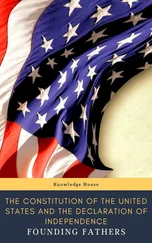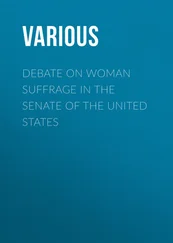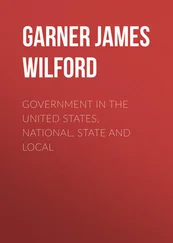Jeffrey Lewis - The 2020 Commission Report on the North Korean Nuclear Attacks Against the United States
Здесь есть возможность читать онлайн «Jeffrey Lewis - The 2020 Commission Report on the North Korean Nuclear Attacks Against the United States» весь текст электронной книги совершенно бесплатно (целиком полную версию без сокращений). В некоторых случаях можно слушать аудио, скачать через торрент в формате fb2 и присутствует краткое содержание. Город: New York, Год выпуска: 2018, ISBN: 2018, Издательство: Mariner Books, Жанр: Фантастика и фэнтези, Триллер, на английском языке. Описание произведения, (предисловие) а так же отзывы посетителей доступны на портале библиотеки ЛибКат.
- Название:The 2020 Commission Report on the North Korean Nuclear Attacks Against the United States
- Автор:
- Издательство:Mariner Books
- Жанр:
- Год:2018
- Город:New York
- ISBN:9-781-328-57391-9
- Рейтинг книги:4 / 5. Голосов: 1
-
Избранное:Добавить в избранное
- Отзывы:
-
Ваша оценка:
- 80
- 1
- 2
- 3
- 4
- 5
The 2020 Commission Report on the North Korean Nuclear Attacks Against the United States: краткое содержание, описание и аннотация
Предлагаем к чтению аннотацию, описание, краткое содержание или предисловие (зависит от того, что написал сам автор книги «The 2020 Commission Report on the North Korean Nuclear Attacks Against the United States»). Если вы не нашли необходимую информацию о книге — напишите в комментариях, мы постараемся отыскать её.
The 2020 Commission Report on the North Korean Nuclear Attacks Against the United States — читать онлайн бесплатно полную книгу (весь текст) целиком
Ниже представлен текст книги, разбитый по страницам. Система сохранения места последней прочитанной страницы, позволяет с удобством читать онлайн бесплатно книгу «The 2020 Commission Report on the North Korean Nuclear Attacks Against the United States», без необходимости каждый раз заново искать на чём Вы остановились. Поставьте закладку, и сможете в любой момент перейти на страницу, на которой закончили чтение.
Интервал:
Закладка:
South Korean military authorities, meanwhile, had initiated standard procedures of their own. They had detected the missile launch and explosion. These officials also began notifying their superiors and sending their message up and out. These two messages—that a civil airliner had been lost and that North Korea had shot it down—began racing through South Korea’s government, winding their way up and up the chain of command and ultimately reaching the office of the South Korean president himself.
The President of South Korea lived in an elegant palace with the lilting name Cheong Wa Dae, which is literally translated as the Pavilion of Blue Tiles—a reference to the azure tiles of its distinctive, traditional Korean roof. In English, however, South Koreans simply called it “the Blue House.” This name was easier to remember and pronounce for the American military officers and diplomats who arrived in-country knowing little or nothing about Korea and speaking only a few words of the language. But like many things in Korea, this simple name obscured a fundamentally different reality.
The White House, for example, is a single building in which the president’s key advisers are close at hand. The chief of staff, national security adviser, and essential White House staff cram themselves into tiny offices that have no redeeming feature except proximity to the Oval Office—and in the toughest moments, the Situation Room. In Washington, proximity is what matters.
The Blue House had little in common with the White House. It wasn’t even a house . There was a house, to be sure, but Cheong Wa Dae was a complex of buildings, spread across a kind of campus. Key staff members, including the president’s chief of staff, had workspaces in a series of contemporary office buildings that looked nothing like the traditional main building that sheltered the president’s office under those beautiful blue tiles. The president’s residence was in yet another building, a short walk away. In the event of an emergency, the president’s aides had to converge on the main building, where they would gather in the Crisis Room that sat beneath it. To do so, they had to walk ten minutes or more across the palace grounds, passing through two gates and a guard post, before entering the main building and descending into the small bunker beneath.
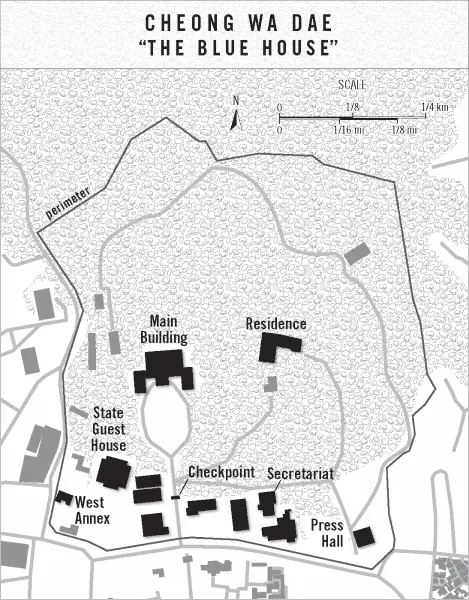
South Korean officials had long complained that this layout made it take far too long for officials to gather in an emergency. As Kwon Hyuck-ki, former chief secretary to the president of South Korea, said, “It is retrogression of sorts that the president’s office exists as a small Cheong Wa Dae within Cheong Wa Dae .” In 2010, after North Korea began shelling a South Korean island, it took some twenty minutes for the key national security staff to assemble in the bunker.
South Korean president Moon Jae-in, too, had complained about the luxurious palace that housed his predecessors—including Park Chung Hee, the dictator who had jailed a young Moon for participating in a student protest. One of Moon’s campaign pledges had been to relocate his office and other functions to a government facility about a mile south of Cheong Wa Dae. But even after the move to the Central Government Complex was largely completed in early 2020, the Cheong Wa Dae complex retained two very important government functions: it remained the president’s residence, and it continued to house the underground Crisis Room, known simply as “the bunker.”
Early in the afternoon of Saturday, March 21, President Moon was at his residence, thinking about ships, not aircraft. He was looking over remarks that he would deliver a few days later at a shipyard—where he would announce progress on a public corporation that would aid South Korea’s struggling shipbuilding industry—when the message arrived.
At 12:35, Im Jong-seok, Moon’s chief of staff, knocked on the door and told Moon that a South Korean airliner en route from Busan to Ulan Bator had disappeared from radar screens over the Yellow Sea and was presumed lost. Moon asked Im to convene his security council. A few minutes later, Im returned with a second message. The South Korean military had detected a surface-to-air missile launch from North Korea that was believed to be the cause of the loss of the aircraft. At this point, Moon went immediately to the underground Crisis Room.
Moon sat at the head of an empty table, waiting for his national security team to arrive. As he waited, he appeared to grow anxious and then irritated at the delay. “He wasn’t the sort of man who fidgeted,” recalled Im. “This was the first time I saw him tapping his pen on the table. That’s the memory of him that stays with me, him sitting in that room, just waiting.”
Weighing on Moon were the political dangers of appearing indecisive. “I am sure the Sewol was in his mind,” Im explained, “because he made a bitter comment about ‘seven hours.’” “Seven hours” referred to the long period of inaction on the part of the South Korean government that followed the sinking in 2014 of the South Korean ferry MV Sewol . Then-president Park Geun Hye had waited most of the day before convening an emergency meeting of her security advisers, a delay that permanently turned public opinion against her. Many of her political opponents, including Moon, had demanded to know what became of the “seven missing hours” when the passengers of the Sewol, most of them students, were drowning. Park’s aides had not offered a convincing explanation, allowing wild rumors to spread. She had been in an assignation with an aide, one tabloid claimed, while another reported that she was having plastic surgery.
Park was eventually impeached for corruption and sentenced to twenty-four years in prison. But Moon and his aides believed that the public anger toward Park had its roots in the Sewol disaster. They had seen evidence of her malfeasance firsthand: upon taking office, Moon’s staff found a cache of documents that showed that Park’s aides had lied about when she was notified about the disaster. They turned the documents over to investigators and filed a complaint with the Seoul prosecutor’s office. Moon’s surviving aides all believe that he was determined not to repeat Park’s mistakes. “Moon was so hard on Park over her failure with the Sewol ,” Im recalled. “He was not going to open himself up to the same criticism.”
This crisis was precisely what Moon had tried to avoid. The president had thought that North Korea’s participation in the 2018 Winter Olympics in Pyeongchang, South Korea, might offer the chance to fundamentally change the relationship between the two countries. President Moon had been an unapologetic advocate for reviving the “Sunshine Policy” of South Korea’s first progressive president, Kim Dae Jung. The idea was simple: hostility toward North Korea would only make Kim Jong Un cling to his nuclear weapons, the same way a cold wind might make a man draw a heavy winter coat around him. If you want the man to take off the coat, the warm sunshine is far more effective.
It was inevitable that the new version of the policy would be nicknamed “Moonshine.” The term was a pun on the president’s name, of course, but it also conveyed a certain weary skepticism about the enterprise. It wasn’t an indictment of diplomacy per se , so much as a weary acceptance that all of the policies tried to date, both hard and soft, had failed to deliver a Korean Peninsula free from nuclear danger. It is only with hindsight, perhaps, that the brief and intense period of summit diplomacy that followed the 2018 Olympics seems like a heroic effort to avert a catastrophe.
Читать дальшеИнтервал:
Закладка:
Похожие книги на «The 2020 Commission Report on the North Korean Nuclear Attacks Against the United States»
Представляем Вашему вниманию похожие книги на «The 2020 Commission Report on the North Korean Nuclear Attacks Against the United States» списком для выбора. Мы отобрали схожую по названию и смыслу литературу в надежде предоставить читателям больше вариантов отыскать новые, интересные, ещё непрочитанные произведения.
Обсуждение, отзывы о книге «The 2020 Commission Report on the North Korean Nuclear Attacks Against the United States» и просто собственные мнения читателей. Оставьте ваши комментарии, напишите, что Вы думаете о произведении, его смысле или главных героях. Укажите что конкретно понравилось, а что нет, и почему Вы так считаете.
